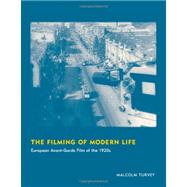The Filming of Modern Life: European Avant-garde Film of the 1920s

The Filming of Modern Life: European Avant-garde Film of the 1920s
- ISBN 13:
9780262015189
- ISBN 10:
0262015188
- Format: Hardcover
- Copyright: 01/28/2011
- Publisher: Ingram Publisher Services, Inc.
- Newer Edition
Rent
Sorry, this item is currently unavailable.
Note: Supplemental materials are not guaranteed with Rental or Used book purchases.
Extend or Purchase Your Rental at Any Time
Need to keep your rental past your due date? At any time before your due date you can extend or purchase your rental through your account.
Summary
In the 1920s, the European avant-garde embraced the cinema, experimenting with the medium in radical ways. Painters including Hans Richter and Fernand Leger as well as filmmakers belonging to such avant-garde movements as Dada and surrealism made some of the most enduring and fascinating films in the history of cinema. In The Filming of Modern Life, Malcolm Turvey examines five films from the avant-garde canon and the complex, sometimes contradictory, attitudes toward modernity they express: Rhythm 21(Hans Richter, 1921), Ballet mecanique(Dudley Murphy and Fernand Leger, 1924), EntrOEacte(Francis Picabia and Rene Clair, 1924), Un chien andalou(Salvador Dali and Luis Bunuel, 1929), and Man with a Movie Camera(Dziga Vertov, 1929). All exemplify major trends within European avant-garde cinema of the time, from abstract animation to OEcinema pur.OE Turvey argues that these films share a concern with modernization and the rapid, dislocating changes it was bringing about. He critically addresses major theories of the avant-garde and its relation to modern life, including the claim that film is OEdistractingOE in the same way as a modern environment, and he challenges the standard view of the avant-garde as implacably opposed to bourgeois modernity. In fact, he writes, not only was there considerable disagreement among avant-garde movements about what aspects of modern life needed transformation, but the positions of individual avant-garde artists toward modernization were complex, even contradictory. All five films that Turvey analyzes embrace and resist, in their own ways, different aspects of modernity. Although much has been written about each of these films, The Filming of Modern Lifeis the first book to examine them together, illuminating their shared concern with modernization and its consequences.







